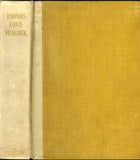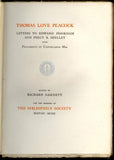Thomas Love Peacock: Letter to Edward Hokham and Percy B Shelley with fragments of Unpublished Manuscript
Author: Peacock, Thomas Love (1785-1866)
Year: 1910
Publisher: Bibliophile Society
Place: Boston
Description:
250pp with frontispiece. Royal octavo (9 1/2" x 6 3/4") issued in yellow cloth with faux velum for spine with gilt lettering. Edited with an introduction by Edward Garnnett. Limited to 483 copies. 1st edition.
Thomas Love Peacock is best remembered as one of the great satirists of the Romantic period. Early in his writing career he made use of the Arthurian legends, mainly for satire, amusement, and instruction. His first Arthurian story, "Satyrane; or, The Stranger in England," was written around 1811 or 1812, and completed in 1816. Satyrane refers to a character in Spenser's The Faerie Queen, one who is part beast, but has an innately virtuous will. This incomplete work is about a missionary stranded on an island after a shipwreck. "Satyrane" later became absorbed in another unfinished romance "Calidore," published in 1816. Like Satyrane, Calidore is a figure of courtesy from the Faerie Queen. Other Romantic writers had an interest in the Calidore figure such as John Keats and Robert Southey. Keats wrote an unfinished poem entitled "Calidore" during 1818. In Peacock's comic story, Calidore, on his way to London, arrives by boat on an island. He explains to some lounging travelers that he is following King Arthur's instructions for him to find a philosopher and a wife in London. In the next fragment he, and King Arthur's court, arrive on a deserted island. They are greeted by Greek gods and goddesses. With Arthur's instructions to enjoy himself on the island, Calidore becomes a reveler. This merging of different historical periods reflects Peacock's interest in opposing the Ancient and Modern worlds. Eventually Calidore gets to London. In a comic scene, he tries to exchange Arthurian gold coins for paper money. This tale, like his novels, illustrates Peacock's satirical approach to romances. In 1814 Peacock published "Sir Hornbook; or, Childe Lancelot's Expedition, A Grammatico-Allegorical Ballad." His intention was to teach children "grammar without tears." "Sir Hornbeck" surveys parts of speech by representing them as characters of chivalric romance. This very popular book went through five editions in five years. Fifty years later it was published again and it regained its former popularity.
Condition:
Corners bumped, soiled, glue stain from book plate removed from front paste down. A very good copy.
Year: 1910
Publisher: Bibliophile Society
Place: Boston
Description:
250pp with frontispiece. Royal octavo (9 1/2" x 6 3/4") issued in yellow cloth with faux velum for spine with gilt lettering. Edited with an introduction by Edward Garnnett. Limited to 483 copies. 1st edition.
Thomas Love Peacock is best remembered as one of the great satirists of the Romantic period. Early in his writing career he made use of the Arthurian legends, mainly for satire, amusement, and instruction. His first Arthurian story, "Satyrane; or, The Stranger in England," was written around 1811 or 1812, and completed in 1816. Satyrane refers to a character in Spenser's The Faerie Queen, one who is part beast, but has an innately virtuous will. This incomplete work is about a missionary stranded on an island after a shipwreck. "Satyrane" later became absorbed in another unfinished romance "Calidore," published in 1816. Like Satyrane, Calidore is a figure of courtesy from the Faerie Queen. Other Romantic writers had an interest in the Calidore figure such as John Keats and Robert Southey. Keats wrote an unfinished poem entitled "Calidore" during 1818. In Peacock's comic story, Calidore, on his way to London, arrives by boat on an island. He explains to some lounging travelers that he is following King Arthur's instructions for him to find a philosopher and a wife in London. In the next fragment he, and King Arthur's court, arrive on a deserted island. They are greeted by Greek gods and goddesses. With Arthur's instructions to enjoy himself on the island, Calidore becomes a reveler. This merging of different historical periods reflects Peacock's interest in opposing the Ancient and Modern worlds. Eventually Calidore gets to London. In a comic scene, he tries to exchange Arthurian gold coins for paper money. This tale, like his novels, illustrates Peacock's satirical approach to romances. In 1814 Peacock published "Sir Hornbook; or, Childe Lancelot's Expedition, A Grammatico-Allegorical Ballad." His intention was to teach children "grammar without tears." "Sir Hornbeck" surveys parts of speech by representing them as characters of chivalric romance. This very popular book went through five editions in five years. Fifty years later it was published again and it regained its former popularity.
Condition:
Corners bumped, soiled, glue stain from book plate removed from front paste down. A very good copy.













